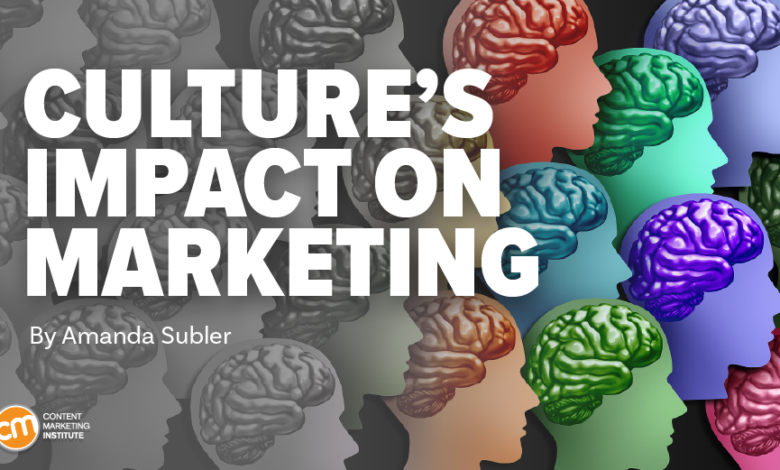Why Culture is Key to Brand Marketing Influence

I recently interviewed Marcus Collins, author of For the Culture: The Power Behind What We Buy, What We Do, and Who We Want To Be, to an episode of Live With CMI (with my co-host, JK Kalinowski). Marcus is an award-winning marketer who is the former Chief Strategy Officer at Wieden+Kennedy New York and Clinical Assistant Professor of Marketing at the University of Michigan Ross School of Business.
Our discussion on the role of culture in marketing covered more than we could fit in a single episode, so we’ve released a bonus video of our entire conversation. Watch it here or read the edited transcript below.
Why should culture matter to marketers?
Culture is an organizing operating system that ultimately influences just about everything we do as human beings. And that’s important for marketers because your job is to influence behavior, and there is no external force more influential on human behavior than culture.
When you launch something – a new campaign, a new product – it is negotiated and constructed according to the discourse at hand. Suppose you launch a new brand of carrots when an outbreak of E. coli affects carrots. You are negatively affected by what is happening in the cultural zeitgeist.
Influencing and impacting culture means contributing to the discourse in a meaningful way. My friend Eric Hultgren says that culture is like a car:
You can drive it: You bring new ideas or new conventions.
You can use a shotgun: You commit to existing conventions.
You can vacuum the exhaust pipe: You simply follow everything that happens without point of view and no clear conviction.
Brands that lead culture bring new artifacts, new language, and new behaviors through their works. These are the brands most likely to win.
Is authenticity linked to culture?
Scholar Eric David Brown Jr. talks about the authenticity that occurs when one is one’s truest self despite context. The same goes for brands. Brands are authentic when they are the same, no matter who they are with or where you find them. They receive a level of credibility that helps them engage meaningfully with the culture.
If you are known to be inauthentic, it may be extremely difficult, if not impossible, to engage and contribute in a lasting way.
Bud Light taps into culture
In the late 1990s, Budweiser identified a cultural product in the form of a short film by Charles Stone III, a music video producer who wanted to break into Hollywood. Charles and his friends made a film (three minutes long) called TRUE. The dialogue was mostly “Wassup?” – this was how they communicated without having to say more words.
The head of DDB, Budweiser’s advertising agency, saw the short film and said, “That’s exactly what we’re trying to capture in this brand.” » So, Budweiser commissioned Charles Stone to rework his short film into an advertisement for Budweiser. People who saw themselves in this short film – in this cultural work – started using this “Wassup?” language to speak to each other. This cultural lexicon has become a means of signifying proximity. It’s a receipt of friendship.
Budweiser thus identified the language used by this group. This was not new, but the brand engaged in this lexicon through these cultural creators to benefit from the equity associated with it. And Budweiser was like, “Wassup?” to the bank. And that was also the case Charles Pierrewho found his place in Hollywood making films.
Everyone associated with “Wassup?” » The campaign won not because of changes to the product but because of the brand’s ability to be close to the culture.
Beyoncé sees the true power of BeyHive
Part of my work with Beyoncé was helping her build her online fan club. Take an offline fan club, where people write him letters that would go unanswered (like most celebrities), and turn it into an online fan club where these people could interact with each other through their Beyoncé fandom.
However, we realized that engagement on the platform we built was nowhere near comparable to engagement within the (broader) community. In the BeyHive clubs, these people had their own language, their own vernacular, their own artifacts, and their own behaviors.
They weren’t just Beyoncé fans. They saw the world like Beyoncé. Their belief system brought them together. Music was only the cultural production that expressed the common belief exchanged between them.
What this illuminated for me is that building community is “I’m going to bring people in and rally them around me and my ideas.” Facilitating community is about finding people who already believe in what you believe and using your resources, effort, and social capital to help them connect so they can collectively achieve the things they set out to achieve together.
Although one might consider this a play on words, I think (thinking) is fundamentally, if not philosophically, different. When you lead a community, you find yourself serving people. And the best marketing is always in the service of helping people do their work, whether it’s functional work, emotional work, social work, or the alchemy of all three.
So marketers should look for those communities that may already exist for their brand, product or whatever. This requires the brand to be more than a product manufacturer or service-based product provider.
The idea is that these vectors of meaning that we call brands transcend the value proposition, the category in which they operate. Then they preach the gospel to people who see the world the same way. And these people say, “Yes, absolutely, I’ve always thought of things that way. Finally, someone said it. Then these people preach the Gospel for you. They evangelize, creating network effects that attract people to you.
B2B and B2C brands can do this. It’s just context. Brands are vectors of meaning, and brands that mean one thing when I’m shopping at the grocery store have the same mechanisms as brands that mean something when I’m in my cubicle trying to decide whether I have to buy this cloud computing system or that. . It all depends on what the brand represents to me.
You know that saying: “No one ever got fired for hiring IBM?” It is because there was cultural credibility and trust at IBM. Therefore, cultural and social expectations are imposed on this (buyer) such that even if he sees a product that performs better than IBM, he will opt for IBM because it is likely that he will go through (the purchase) more through the system. easily. No one is going to get mad at them. The boss would probably give them a pat on the back. The buyer gets all the equity out of it, even if another product may be better.
Kamala Harris didn’t have a big cultural effect on the network
I think people look at Kamala Harris’ presidential campaign and say, “Well, her efforts weren’t effective enough because she didn’t win.” » I say, “Well, no, not really. »
She preached the Gospel. She started with what she believed, and people who saw the world said the same way: “She’s my candidate.” »
The truth is that the country did not believe what it believed. Should she have said something she didn’t believe to win? So people would say, “Well, that’s not authentic. »
It’s like brands that say they believe in something, and some people say, “No, I’m not choosing you.” Thus, the brand declares: “We should not have said what we believed. » Well no. The people who chose your brand (because of what you shared) are the ones to target.
In the political game, it is a binary question: a winner and a loser. In the market, a brand cannot be number 1 and still win. You could be #5 and profitable.
Plus, in politics, it’s not enough to preach the gospel to people who see the world the way you do. You need to create the mechanisms by which you trigger network effects.
Maybe Kamala didn’t have enough time for this to sink in because she didn’t compete in the race until July. She only got the first reaction from believers and did not have the chance to benefit from their ability to influence others.
The momentum it has catalyzed in a short time is unprecedented. She raised a billion dollars in donations. It’s unreal. What she did was a Herculean effort. Was his campaign perfect? No. But did it have an impact? 1000%.
Want more content marketing tips, insights, and examples? Subscribe to daily or weekly emails from CMI.
HANDPICKED RELATED CONTENT:
Cover image by Joseph Kalinowski/Content Marketing Institute



